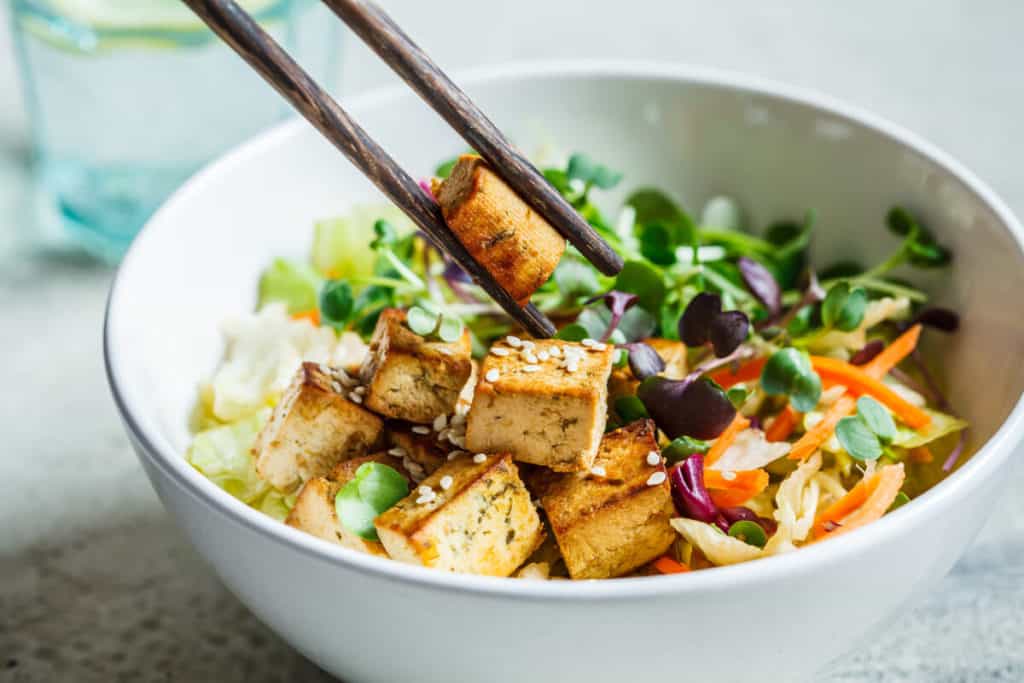Continue reading to learn more about soy, its health effects, and its impact on hormonal health.

What is soy?
Soy is a nutrient-dense legume, rich in B vitamins, fiber, potassium, and magnesium. (19) Unlike many plant foods, soy is a “complete” protein, meaning it contains the nine essential amino acids that the body cannot synthesize and must be obtained from food. (10)While soy is a common component of traditional east Asian diets, only recently have individuals started consuming it as a supplemental plant-based protein. In North America, it is now a staple in many vegetarian and plant-based diets, as well as a common ingredient in many food products, including baby food, animal feed, and processed meat replacements. (5)
Soy also contains isoflavones, classifying it as a phytoestrogen, plant compounds that can act like estrogen in the body. (9) It is this component that has led to the debate over its benefits and potential harmful effects. For example, some animal studies have linked phytoestrogens to infertility, leading to a concern about the effects of soy on the human body. (5)
What are phytoestrogens?
A phytoestrogen is a naturally-occurring chemical in plants, particularly legumes and sprouted vegetables, that exhibits estrogenic activity. (8) Phytoestrogens were first discovered in Australia during in the 1940s when there was an outbreak of infertility among sheep who grazed in a field of clovers, another phytoestrogenic plant. (15)Phytoestrogens have the ability to bind to estrogen receptors in the human body, potentially mimicking the effects of estrogen, or alternatively, blocking estrogen from acting on certain receptors. Estrogen is a sex hormone involved in key body processes, such as sexual maturation, reproductive health, cardiovascular health, bone health, and cognitive health, in both men and women. (9)
While there are many benefits attributed to phytoestrogens, such as a lowered risk of osteoporosis and heart disease, they are also considered to be endocrine disruptors, which means they can interfere with endocrine (or hormonal) systems. (1)(11)
Phytoestrogens can be divided into three main categories, which include isoflavones, coumestans, and lignans. Some isoflavones have been shown to inhibit pathways involved in cell growth, which can have both positive and negative effects. At high doses, some isoflavones suppress over-expression of cell growth in the brain and can be neuroprotective. (17)

Effects and benefits of soy
Generally, soy based products are a nutritious source of protein that are safe to eat three to five times per week. The recent increase in the popularity of soy can be attributed in part to the health statistics coming from populations with high soy intake. For example, East Asian populations tend to consume more soy in their diet and also report lower rates of cardiovascular disease, menopausal symptoms, breast cancer, diabetes, and obesity. (1)(2)(12)(19) In fact, studies have found evidence that soy may lower cancer rates, including breast and prostate cancer rates. (3)(5)(7)(13)(16)(22)However, there is some evidence, primarily animal studies, that indicate that phytoestrogens may negatively impact parts of the brain and alter behavior by disrupting memory and motor function. (12) Human studies have also provided some evidence that soy may reduce fertility, though these effects are only demonstrated when there is also an extremely high amount of sodium consumed in the diet (up to four times more than someone who eats soy regularly would consume). (9) Currently, there is no conclusive evidence which suggests that certain groups of people can be specifically negatively affected by soy. However, theoretically, individuals receiving hormone therapy or have hormone-sensitive cancer could be at an increased risk and would have unique health considerations. Please consult your healthcare practitioner for information related to your own health.

Not all soy is created equal
Some soy products may be better than others. The benefits of soy appear to be greater for whole soy products, such as tofu, soybeans, or edamame, compared to processed soy products, such as many veggie burgers and meat replacement products found in grocery stores. (10)Soy products manufactured in the United States are often highly processed, adding in sugars and salts that take away from the health benefits of soy. (5) Due to the rising interest in alternatives to animal proteins, many “fake meat” products, such as vegetarian chicken nuggets, are largely soy-based to provide protein and acts as a filler. (9) Many of these soy fillers contain genetically modified organisms (GMOs), and individuals may choose to seek out organic, non-GMO soy products to reduce the risk of potential harmful effects.
The bottom line
Overall, soy is a nutrient-rich, plant-based protein that has numerous benefits, particularly when consumed as a whole food. (14) Though some controversy exists about the effects of soy on the body, there is no conclusive scientific evidence that points to consistent negative effects across ethnicity, age, and gender, and an increasing amount of evidence seems to support an overall positive long-term health impact.If you’re a patient, be sure to speak with your integrative healthcare professional if you have concerns about soy intake or supplementing with soy-based protein.
- Adlercreutz, H. (1990). Western diet and Western diseases: some hormonal and biochemical mechanisms and associations. Scandinavian Journal of Clinical and Laboratory Investigation, 50(sup201), 3-23.
- Adlercreutz, H., & Mazur, W. (1997). Phyto-oestrogens and Western diseases. Annals of medicine, 29(2), 95-120.
- Applegate CC, Rowles JL, Ranard KM, Jeon S, Erdman JW. Soy Consumption and the Risk of Prostate Cancer: An Updated Systematic Review and Meta-Analysis. Nutrients. 2018;10(1):40. Published 2018 Jan 4. doi:10.3390/nu10010040
- Campbell, D. R., & Kurzer, M. S. (1993). Flavonoid inhibition of aromatase enzyme activity in human preadipocytes. The Journal of steroid biochemistry and molecular biology, 46(3), 381-388.
- Clinton D. Allred, Kimberly F. Allred, Young H. Ju, Tracy S. Goeppinger, Daniel R. Doerge, William G. Helferich, Soy processing influences growth of estrogen-dependent breast cancer tumors, Carcinogenesis, Volume 25, Issue 9, September 2004, Pages 1649–1657.
- Erdman Jr, J. W., Badger, T. M., Lampe, J. W., Setchell, K. D., & Messina, M. (2004). Not all soy products are created equal: caution needed in interpretation of research results. The Journal of nutrition, 134(5), 1229S-1233S.
- Fritz H, Seely D, Flower G, Skidmore B, Fernandes R, Vadeboncoeur S, Kennedy D, Cooley K, Wong R, Sagar S, Sabri E, Fergusson D. Soy, red clover, and isoflavones and breast cancer: a systematic review. PLoS One. 2013 Nov 28;8(11):e81968. doi: 10.1371/journal.pone.0081968. PMID: 24312387; PMCID: PMC3842968.
- Jargin S.V. (2020). Soy phytoestrogens: Hormonal activity and impact on the reproductive system. Международный эндокринологический журнал, 16 (2), 156-160.
- Jefferson, W. N. (2010). Adult ovarian function can be affected by high levels of soy. The Journal of nutrition, 140(12), 2322S-2325S.
- Kuiken, K. A., Lyman, C. M., Bradford, M., Trant, M., & Dieterich, S. (1949). Essential amino acid composition of soy bean meals prepared from twenty strains of soy beans. J Biol Chem, 177, 29-36.
- Kurzer, M. S., & Xu, X. (1997). Dietary phytoestrogens. Annual review of nutrition, 17(1), 353-381.
- Lephart, E. D., West, T. W., Weber, K. S., Rhees, R. W., Setchell, K. D., Adlercreutz, H., & Lund, T. D. (2002). Neurobehavioral effects of dietary soy phytoestrogens. Neurotoxicology and teratology, 24(1), 5-16.
- Li W, Ruan W, Peng Y, Wang D. Soy and the risk of type 2 diabetes mellitus: A systematic review and meta-analysis of observational studies. Diabetes Res Clin Pract. 2018 Mar;137:190-199. doi: 10.1016/j.diabres.2018.01.010. Epub 2018 Feb 2. PMID: 29407270.
- Messina, M., Nagata, C., & Wu, A. H. (2006). Estimated Asian adult soy protein and isoflavone intakes. Nutrition and cancer, 55(1), 1-12.
- Murkies, A. L., Wilcox, G., & Davis, S. R. (1998). Phytoestrogens. The Journal of Clinical Endocrinology & Metabolism, 83(2), 297-303.
- Nachvak SM, Moradi S, Anjom-Shoae J, Rahmani J, Nasiri M, Maleki V, Sadeghi O. Soy, Soy Isoflavones, and Protein Intake in Relation to Mortality from All Causes, Cancers, and Cardiovascular Diseases: A Systematic Review and Dose-Response Meta-Analysis of Prospective Cohort Studies. J Acad Nutr Diet. 2019 Sep;119(9):1483-1500.e17.
- Otun, J., Sahebkar, A., Östlundh, L., Atkin, S. L., & Sathyapalan, T. (2019). Systematic Review and Meta-analysis on the Effect of Soy on Thyroid Function. Scientific reports, 9(1), 3964.
- Patisaul, H. B., & Jefferson, W. (2010). The pros and cons of phytoestrogens. Frontiers in neuroendocrinology, 31(4), 400–419.
- Reinwald, S., & Weaver, C. M. (2010). Soy components vs. whole soy: are we betting our bones on a long shot?. The Journal of nutrition, 140(12), 2312-2317.
- Rose, D. P., Boyar, A. P., & Wynder, E. L. (1986). International comparisons of mortality rates for cancer of the breast, ovary, prostate, and colon, and per capita food consumption. Cancer, 58(11), 2363-2371.
- Sacks FM, Lichtenstein A, Van Horn L, Harris W, Kris-Etherton P, Winston M. Soy protein, isoflavones, and cardiovascular health: an American Heart Association Science Advisory for professionals from the Nutrition Committee. Circulation. 2006 Feb 21;113(7):1034-44.
- Taku K, Melby MK, Kronenberg F, Kurzer MS, Messina M. Extracted or synthesized soybean isoflavones reduce menopausal hot flash frequency and severity: systematic review and meta-analysis of randomized controlled trials. Menopause. 2012;19(7):776-790. doi:10.1097/gme.0b013e3182410159
- Yu, Douglas. (2020). Plant-Based Foods Are Hot, And They’re Only Getting Hotter. Forbes Magazine. Accessed August 30, 2020.





